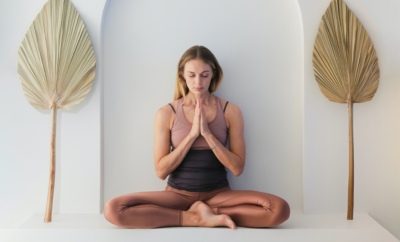Tantra Yoga 101: What It Is and What It Is Not
When you hear the term Tantra Yoga, what do you think of? The Kama Sutra? Sex in pretzel-like positions? If your answer was one of those or somewhere in between, then you are kind of right, but mostly wrong . . .
Honestly, thinking about Tantric Yoga and Tantric sex as being synonymous is like associating cheese synonymously with a pepperoni pizza. Sure, the cheese is part of the pizza, but it isn’t the whole of the pizza.
Tantric Sex: Here’s Everything You Need to Know
The same idea goes for Tantric Yoga and Tantric sex. Tantric sex is a tiny fraction of what Tantric Yoga is all about.
What Exactly Is Tantra Yoga?
Tantra Yoga is first and foremost a personal practice of liberation.
In Sanskrit, the word Tantra means to weave or expand. However, according to Brett Larkin, in a historical and yogic context, Tantra is a scripture, a tool for expansion, and a system of practice.
Thinking about Tantric Yoga and Tantric sex as being synonymous is like associating cheese synonymously with a pepperoni pizza.
As a practice, Tantra is a comprehensive and practical system of spirituality that employs the whole human being (attention, imagination, body, and breath) to bring the practitioner to a place free from suffering and ignorance.
The Science Behind Yoga and Spirituality: 3 Reasons Yoga Leads to Spiritual Growth
Tantra embraces all aspects of life – work, home, family, sex, and desire – and aims to merge the spiritual and the material, which – at the time of its origination (approximately 500 CE) – was pretty radical.
In addition to incorporating all aspects of life, Tantra also takes the whole person into account and works with five different bodies:
- The physical body
- The energetic body
- The wisdom body – also known as the inner teacher
- The mental/emotional body
- The bliss body
Each body has its own strengths and weaknesses that are buried within us. Tantra helps to bring them to the surface so we can avoid responding unconsciously and, instead, gain control over our needs and desires.
Tantric practice consists of ritual, daily life, and yogic practices which include:
- Yoga asana (poses)
- Mudra
- Mantra
- Bandha (energy locks)
- Yantra (mystical diagram)
- Pranayama (breathing exercises)
- Chakra (energy center)
- Meditation
- Visualization
- Kundalini practices
You likely noticed that much of what we simply call “yoga” in the Western world has a direct or indirect root in Tantric practices. Hatha Yoga, Kundalini Yoga, and Kriya Yoga are all traditions that arose from Tantra Yoga.
What Is Tantra Yoga NOT?
Tantra Yoga isn’t sex. This is a very common misconception which stems from hearsay and a misunderstanding of ancient texts.
Neo-Tantra, also known as Modern Tantra, NavaTantra, sacred sexuality, and Tantric sex, is the new-age Western take on Tantra. People often mistake Neo-Tantra as encompassing all of Tantra, which isn’t accurate.
According to Brett Larkin, this misunderstanding stems from the work of pioneers John Woodroffe, Aleister Crowley, and Pierre Bernard in the early 1900s.
Tantra Yoga isn’t sex.
The problem occurred when these folks shared their interpretation of Tantra Yoga with the West, which was formed without access to original texts and with an emphasis on sexual practice.
It was that emphasis on sex plus Tantric symbolic imagery of deities engaging in sexual acts that led to the common misconception that Tantra means sex. The one feature that Neo-Tantra and Classical Tantra have in common is that sexuality does not have to be separate from spirituality.
For the Classical Tantra practitioner, sexuality is just one part of the human experience that can have a spiritual purpose. On the other hand, the Neo-Tantra practitioner focuses on sex and sexuality for pleasure enhancement.
What Is the Point of Tantra Yoga?
According to Rod Stryker, a world-renowned Tantra Yoga teacher, the goal of Tantra Yoga is threefold:
- To thrive
- To prosper
- To bring the spiritual world and the material world into one
He states: “Tantra Yoga shows us what is blocking us from thriving, and offers techniques that will help us attain spiritual and material prosperity.”
He further explained that, at conception, we are pristine beings. As we grow and move through life, various factors come into play that cause imbalances within us.
We are conditioned by society, teachers, our relationships, and experiences that we go through. All of this takes us further away from our pure selves. Tantra helps to bring us back to our pure selves.
Tantra practitioners say that a regular Tantric practice can lead to: improved sleep quality, a better understanding of and love for oneself, more confidence sexually, increased capacity for intimacy, and reduced anxiety and depression.
How Is Tantric Yoga Different From Tantric Sex?
Tantric Yoga and Tantric sex are from different branches of Tantra.
Classical Tantra is broken into two branches: White Tantra and Red Tantra. White Tantra is the individual practice and Red Tantra is the partnered, or sexual practice.
In addition, the goal of the two practices are quite different. The goal of Red Tantra is to create a deeper connection between the partners whereas with White Tantra, the goal is to create a deeper connection to the self.
What Does a Tantra Practice/Class Look Like?
With Tantra, it is all about the approach rather than the exact movements or activities that you engage in.
Unlike Ashtanga Yoga, for example, there are not a specific set of poses that you will practice in a Tantric practice. Each Tantra Yoga teacher’s class will look different than another’s.
Tantra Yoga is a deeply meditative practice combining standing Hatha positions and floor-based Yin positions.
A Tantra Yoga practice will consist of yoga asana (poses), chanting, meditation, chakra work, and breathwork. However, most Tantra classes will include inversions, side bends, forward folds, twists, and backbends.
What Should I Look for in a Tantra Class?
Most Tantra Yoga classes in Western culture are focused on sex and sexuality rather than the more yogic and individual aspects of Tantra. Some key things to look for to determine if a class is truly a Classical Tantra class are:
- Is the class structured for partners or individuals? (Classical Tantra should be individual focused)
- Does the class include chanting? (A yes would indicate a Classical Tantra focus)
- What is the goal of the class? (A focus on self-growth or self-awareness is ideal)
- What is the teacher’s area of training? (Hatha Yoga, Integral Yoga, Kundalini Yoga, or Tantra Yoga is ideal)
Where Can I Learn More About Tantra Yoga?
Diving into all there is to learn about Tantra Yoga can be overwhelming. Not only is there a great deal to learn, but there is also a seemingly endless amount of resources out there.
Below are some books and texts that will help get you started:
- The Yoga Tradition: Its History, Literature, Philosophy, and Practice by Georg Feurerstein
- The Radiance Sutras by Lorin Roche and Shiva Rea
- The Undiscovered Self by Carl Jung
- Tantra: Path of Ecstasy by Georg Feurerstein
- Tantra Illuminated: The Philosophy, History, and Practice of a Timeless Tradition by Christopher D. Wallis
- The Yoga of Light: Hatha-Yoga-Pradipika by Hans-Ulrich Rieker
- Shiva Samhita: A Classical Text on Yoga and Tantra by Srisa Chandra Vasu
- Tantra: The Supreme Understanding by Osho
Here Are Four Ways to Integrate Tantra Yoga Into Your Life:
1. Find Stillness and Quiet
This isn’t referring to any specific breathwork or meditation, this is simply sitting still and focusing on your body’s sensations in a quiet space.
As you sit, focus on taking long deep breaths and take notice of any physical sensations, impulses, thoughts, and emotions that may arise.
This simple technique can help you to gain a greater sense of connection with your mind-body energies and to train yourself to relax into whatever is in any given moment.
2. Put Aside Flexibility or Physical Fitness as Your End Goal
Classical Tantra isn’t about flexibility or physical fitness. Instead, it is about connecting with yourself on a cellular level so that you can thrive and grow spiritually.
Many of us spend our days facing stressor after stressor – work, traffic, family, school, money, etc. Even when you feel like you’re managing your stress well, your body holds all of that anxiety, fear, and sadness even when you aren’t thinking about it.
In many instances, this means that your body is in flight-fight-or-freeze mode almost constantly.
A classical Tantra practice is designed to facilitate total relaxation. When you’re able to release the tension in the body and mind, you’re better able to connect with your true self. The flexibility and physical fitness will come as a natural result of this connection and your practice.
3. Lean Into Pleasure
Tantra Yoga will prepare your body to receive and experience pleasure. But note that I’m not referring to sexual pleasure here.
Pleasure is often only thought of in terms of sex and sexuality because pleasure creates enjoyable sensations in the body. However, Tantric principles state that pleasure should be felt with all things in life.
You might consider making a list of things that bring you pleasure. This list could include things like a yoga class, hiking, cuddling with a loved one or beloved pet, eating ice cream, taking a long bath, or gardening.
Once you have this list, refer to it often and incorporate those things into your life often and do your best to savor every moment you spend doing them.
4. Find Sacred in the Mundane
Most of us have very busy lives that are full of distractions on an almost constant basis. This can make it really difficult to appreciate and truly absorb all the beauty we encounter on a daily basis.
To help you begin to take notice of the sacred within the mundane, you can practice turning off auto-pilot when you’re doing routine tasks like washing your hair.
Observe the sensations like the smell of the shampoo, the feel of the suds between your fingers, the feel of the water washing over you, or the heat of the water.
Notice where your mind takes you as you practice this and do your best to perform the activity with intention. Intention leads to a feeling of sacredness.
Revel in your ability to be a manifestation of the divine having this unique experience. You’ve never washed your hair before at this exact moment – it is unique!
Tantra Yoga Isn’t About Sex, It’s About Finding Yourself!
While Tantra Yoga can help to improve your sex life because it helps you to become more present with yourself, that is not the point or focus of the practice.
The point of Tantra is to weave together the various aspects of life as we know it. Nothing in life exists independently, everything is part of the same reality.
Tantra helps you to reconnect with your true self and increases your vitality. It helps you to unite your body, mind, and spirit together to bring you closer to your true self.
We are always in the process of becoming, which means that there is always something new to learn about yourself. Tantra teaches you how to relax and let go enough so that you can actually see and feel who you are in that moment.
If you’ve ever been interested in learning more about Tantra Yoga, set aside some time to dive in and begin your journey of digging deeper into yourself.



























Comments